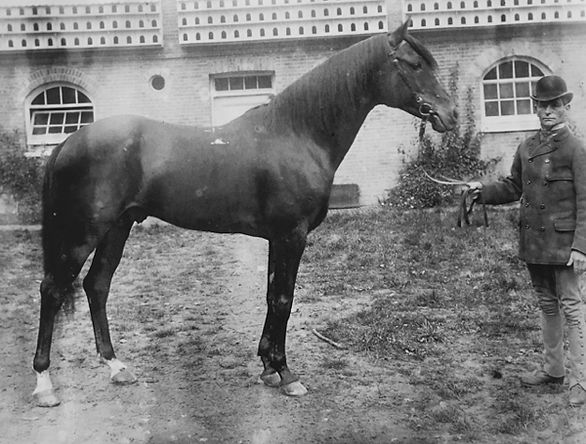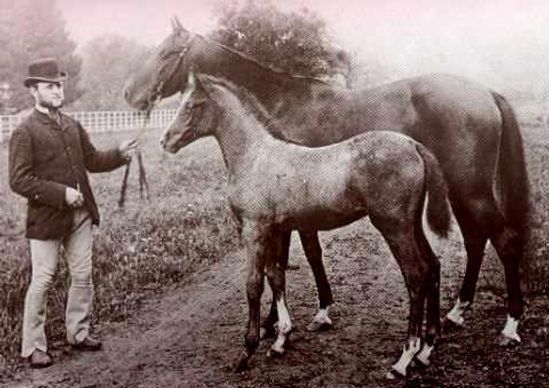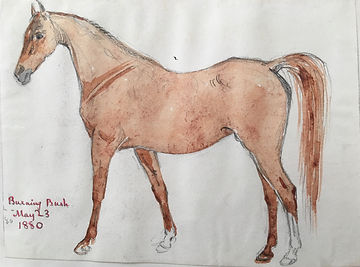On this day!
Words by Natalie Tindall
Picture the moment exactly 140 years ago on 2ndJuly 1878 when six horses arrived by nightfall at the country railway station of Three Bridges in Sussex. They had had a long journey, but not as long as that of the Blunts who had travelled Arabia to find and purchase them.
Lady Anne described the event in her journal:
‘ This evening as we sat at dinner the telegram was brought to me. It was from S. Francis at Folkstone. The horses landed and he would be at Three Bridges tonight by the mail train from Redhill. So I have sent word to Eyles to go down to the station and meet him and the six, Kars, Lady Hester, (Dajania), Palmyra (Hagar), Jerboa , Darley filly(Wild Thyme) and Zenobia (Burning Bush), and I am writing in the hall hoping every minute to hear of their coming.
The night has cleared.’
Records tell us that 1878 was a cool wet summer and as the horses stepped off the train into a chilly darkness, no doubt spooking at the strange shapes of unfamiliar surroundings, they stepped into history. These six pure bred Arabians were the very first beginnings of the Crabbet Stud.

Kars, the first stallion of the Crabbet Stud, imported 2nd July 1878
Kars, a four year old, was the only stallion of the group and was probably the charge of Eyles, the groom in charge of meeting the horses. Although just over 14.2hh Kars was an imposing, strongly built bay horse who had been through a great deal in his young life. He had been shot twice on the battlefields of Arabia, on one occasion being left for dead.
Within three months he was entered into a hurdle race against experienced English Thoroughbreds, having received little training.
Then after a short spell at Crabbet he was sold at the second Crabbet Sale in 1884 for export to Australia where he was lost to purebred breeding but apparently continued to sire very good ‘buggy horses’.
Quite some years later Lady Anne recorded in her journal,
‘In July 1900 heard from HC White Esq. that Kars is still living.’
He was a filly producer and perhaps most notably he sired Rose of Jericho who became one of the foundation mares for Sir James Penn Boucaut’s Quambi stud in Australia. She was also a filly producer and one of her daughters, Rose Diamond, produced Abu Zeyd in 1904.
In 1910 Abu Zeyd was exported to the USA by Homer Davenport where he was subsequently purchased by W R Brown of the Maynesboro Stud who owned him from 1913 -30 where he was the premier sire of Maynesboro Stud. All in all he sired 50 registered purebred Arabians, 46 of which were in the USA.

Dajania with her foal Nefisa
Photo: Crabbet Archives
Lady Hester, born in 1876 and known at Crabbet as Dajania, was a golden bay filly with a beautiful eye, excellent legs and fine action. As with Kars Dajania came with an interesting past even at her tender age. She was stolen from her breeder Mohammed Pasha and was with the Hannadi tribe near Aleppo when the Blunts first saw her. She was the Blunts first purchase and cost £35, which would be approximately £4000 today.
She produced only one pure bred filly, Nefisa by Hadban, but what a filly she turned out to be. Nefisa had eighteen foals and the majority of these bred on, producing the famous ‘N’ line of mares and from these descendants many became foundation horses for studs both here and abroad. Narghileh, a daughter, produced horses who influenced Crabbet breeding in the USA through her son Nasik, Namusa, a granddaughter, had a massive influence on Crabbet breeding in Australia, and even today here in the UK studs such as Coed y Foel owe their foundation mares to this line.

Hagar pictured in 1882
Photo: Crabbet Archives
Hagar was six years old when she arrived at Crabbet but she had already had a remarkable life. As Wilfrid’s journey mare she had travelled well over a thousand miles with them from Aleppo to Baghdad and on to Damascus. She must have been an ideal travelling companion as she was smooth and fast to ride and possessed a gentle temperament. Later sold to Miss Dillon she was a valuable addition to her stud as she was a good broodmare having thirteen foals in total.
Jerboa, a four year old when she arrived, was a bright bay mare with three white feet and a star. She was noted as being a fine mover and fast when galloping but exhibited signs of temper, kicking when in harness. She was entered in the first sale after four years with a high reserve to attract interest and was not sold. She was a quality mare who produced beautiful stock such as the fine colt, Jeroboam, by Pharoah, who was tragically lost at sea in 1887 on his way to Egypt.
A daughter of hers, Jerud also by Pharoah was a foundation mare for Miss Dillon’s stud but she was the only one of her six progeny who bred on through just one of her sons, Jamrood by Maidan who was sold to New Zealand in 1899. This breeding still lives on today though not in pure Crabbet form.
The Darley filly who was named Wild Thyme at Crabbet was described as being disappointing by the Blunts upon her arrival and she proved to be a difficult breeder. However she did have the distinction of being part of a driving pair who took the Blunts and their guests to Derby Day in 1880.
She had a daughter, Raschida by Kars who was sold to Miss Dillon and her line continues to this day. She still has pure and part bred descendants in the USA.

Burning Bush pictured in 1884
Photo: Crabbet Archives

Lady Anne Blunt sketch of Burning Bush in 1880
Photo: Crabbet Archives
Zenobia, or Burning Bush as the Blunts named her, was a chestnut mare with rather a sad story. She disappointed upon arrival and in subsequent years she failed to breed, having just one bay filly by Kars who died at a few days old. She went blind in 1879 and was given to Miss Dillon in 1884. She kept her for several years but still Burning Bush had no progeny.
As we reflect on the historical moment of the arrival of these six Arabians at Crabbet Park and the enormity of influence that they had on future generations it is fitting too to think of the hapless Burning Bush and know that she was valued and cared for in adversity.
What an incredible journey these horses completed when they arrived on this day in 1878 at Three Bridges station and what an even more remarkable journey they began. 140 years on we salute ‘the six.’
